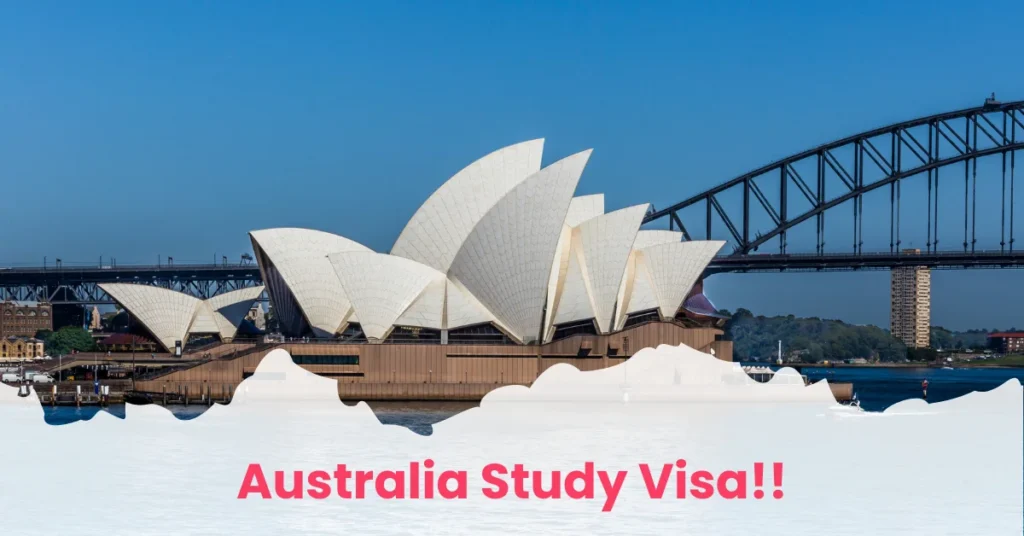Do you dream of doing an MBBS, but you are worried about the high cost of tuition fees and the competitive admissions in India?
Consider studying MBBS in Australia! Australian medical schools are accredited by the Australian Medical Council (AMC) and their degrees are recognised by the Medical Council of India (MCI),
They are also known for their world-class education and research facilities, and they offer a variety of scholarships to international students.
In this blog post, we will provide a comprehensive guide for Indian students pursuing MBBS in Australia, including information on the admission process, visa requirements, cost of living, list of medical universities, and a whole lot more.
We will also share some tips on how to prepare for IELTS and TOEFL exams and write a strong personal statement (SOP).
Why study MBBS in Australia?
There are so many reasons to study MBBS in Australia in comparison to other countries:
- High-quality education: All medical schools in Australia are known for their high-quality and world-renowned education and research facilities.
Australian Medical Council (AMC) accredits all Australian medical schools, and their degrees are recognised by the Medical Council of India (MCI), which means you can practice medicine in India after completing your MBBS in Australia.
- Globally recognised degree: Australian medical degrees are recognised and respected all over the world. As an Indian student with an MBBS degree from Australia, you will have many options for pursuing a career in medicine.
- Strong research culture: Australian medical universities have a strong research culture, and they are constantly innovating and developing new medical treatments and technologies.
This is a bonus point for you, as you will get an opportunity to learn from some of the top medical researchers in the world.
- Opportunities for clinical experience: As a medical student in Australia you will have plenty of opportunities to gain some clinical experience. This is essential for developing the skills and knowledge that you will need to become a successful doctor.
- Affordable tuition fees: If we compare other countries such as the UK and the USA, the tuition fees for MBBS in Australia are relatively affordable. There are also several scholarships available to Indian students who are planning to study MBBS in Australia.
- Supportive student community: Australia is a multicultural country with a large Indian population. This means that you will be able to find a supportive community of Indian students and professionals to help you during your studies.
Overall, an MBBS in Australia for Indian students is a good option if you are looking for high-quality education, affordable tuition fees, globally recognised degrees, and a strong research culture.
Top universities for MBBS in Australia for Indian students
Australian medical schools are highly regarded, and they offer excellent medical education and training.
Here are some of the top medical schools in Australia for pursuing an MBBS degree:
1. University of Melbourne:
It is one of the oldest and most prestigious universities in Parkville, Australia. Its school of medicine is constantly ranked among the top medical universities in the world.
It ranked #14 in the QS World Rankings 2024, #35 in the QS WUR Ranking By Subject, #51 in the QS Sustainability Ranking, and #8 in the Graduate Employment Ranking 2024.
This school offers a four-year MBBS program that covers all aspects of medicine, from basic science to clinical practice, such as
- A year-long program that combines bioscience and clinical education using a unique case-based teaching method.
- Two core clinical training years where you will learn with patients in a wide range of settings.
- Discovery subjects provide you the flexibility to explore areas of your particular interests.
- There is an option to complete an immersive research experience in an area of interest.
- There will be a capstone semester in which you will “rehearse” the skills required for effective and safe clinical practice.
- An annual medical conference that will provide opportunities to interact with leaders in research, policy, and clinical healthcare.
Course Structure
- MD1:
- Foundations for Clinical Practice (FCP)-81.25CP
- Discover 1 Foundation- 12.5 CP
- Student Conference: 6.25 CP
- MD 2:
- Principles of Clinical Practice 2 (FCP2)- 81.25 CP
- Discovery 2 Application- 12.5 CP
- Student Conference- 6.25 CP
- Research Scholar Pathway (MD3)
- Principles of Clinical Practice 3 (PCP3)- 81.25CP
- Discover 3 Research Scholars- 12.5 CP
- Student Conference- 6.25 CP
- MD4
- Transition to Practice (TTP)- 43.75CP
- Discovery 4 Research Scholar (Integrated research project)- 50CP
- Student Conference- 6.25CP
- Clinical Scholar Pathway (MD3)
- Principles of Clinical Practice 3 (PCP3)- 81.25CP
- Discovery 3 Application- 12.5 CP
- Student Conference- 6.25 CP
- MD4
- Transition to Practice (TTP)- 43.75CP
- Discovery 4 Clinical Scholar (Integrated research project)- 50CP
- Student Conference- 6.25CP
- Summer Intake- January
- The total course fee for 2024 for international students is AUD $4,39,425.
2. The University of Sydney
It is also one of the world-renowned universities with a highly regarded medical school. Its school of medicine is constantly ranked among the top medical universities in the world.
It ranked #19 in the QS World Rankings 2024, #67 in the QS WUR Ranking By Subject, #=5 in the QS Sustainability Ranking, and #4 in the Graduate Employment Ranking 2024.
This university offers a 4-year full-time MD course if pursued after your graduation and 7 years if pursued as a joint degree with a BA or BS.
The indicative fee for commencing your MBBS or Doctor of Medicine (MD) at the University of Sydney is AUD 88,500.
Every year there are two commencing intakes, Semester 1 (February) and Semester 2 (July). This course carries 192 credit points that you need to score.
3. Monash University
Monash University is a leading research university with a strong focus on medicine. Its School of Medicine offers a five-year MBBS program that is known for its excellent clinical training.
It ranked #42 in the QS World Rankings 2024, #39 in the QS WUR Ranking By Subject, #=112 in the QS Sustainability Ranking, and #54 in the Graduate Employment Ranking 2024.
The fees for the whole course are 48 credit points which represents a standard full-time course load for a year. The fee for 2024 is AUD 92,200.
To know more about other associated fees you can check Monash University’s website.
Course structure
The course progresses by exploring themes related to personal and professional growth, population dynamics, societal influences on health and illness, the scientific underpinnings of clinical practice, and the acquisition of clinical skills.
These elements converge in the practical application of professional competence during clinical placement experiences.
Theme 1: Personal and Professional Development
This theme centers around the individual doctor, emphasizing the personal characteristics and qualities required for a medical student and, eventually, a medical professional.
It includes aspects such as improving one’s health, fulfilling professional duties, honing communication abilities, mastering information technology, medical informatics, and computing skills, addressing ethical and legal concerns, and enhancing clinical effectiveness.
Theme 2: Population, Society, Health and Illness
This theme primarily emphasizes the societal, environmental, and behavioral factors influencing health and the application of medical practices.
This course focuses on rural and remote healthcare settings, as well as broader societal concerns like health promotion, epidemiology, public health, community diversity, population health, and global health.
Additionally, the program will introduce you to the historical and philosophical aspects of the scientific approach to medicine, and different methods of acquiring knowledge and information, thereby fostering a comprehensive grasp of evidence-based medicine.
Theme 3: Scientific Basis of Clinical Practice
This theme focuses on human systems, and they will help you acquire the foundational knowledge and concepts that support both the fundamental medical sciences and the clinical sciences.
Theme 4: Clinical Skills
This theme covers all the clinical skills you need to learn. It starts with basic communication skills in a medical setting and goes on to things like taking patient histories, doing physical exams, and more advanced clinical and procedural skills.
Alternative Exits
If you meet the requirements, you can leave the double degree program and earn a Bachelor of Medical Science after studying for three years and completing 144 credit points.
(Only for Australian Campuses Only)
4. The University of Queensland
The University of Queensland is a highly-ranked university with a strong reputation for its medical school.
The school offers a four-year MBBS program that is known for its innovative teaching methods and its focus on interprofessional education.
It ranked #43 in the QS World Rankings 2024, #51 in the QS WUR Ranking By Subject, #35 in the QS Sustainability Ranking, and #=105 in the Graduate Employment Ranking 2024.
Course structure
If you are thinking of pursuing your MBBS in Australia from The University of Queensland then you have completed in total 64 units by the end of your course.
Here is the breakdown:
- 16 units for all Year 1 MD core courses- Foundations of Medicine, and
- 16 units for all Year 2 MD core courses- Developing Skills in Medicine, and
- 16 units for all Year 3 MD core courses- Clinical Immersion, and
- 16 units for all Year 4 MD core course- Advanced Practice
The approximate yearly cost of full-time tuition (16 units) for the year 2024 is AUD 91,819. Your fees will vary according to your selected courses and study abroad. Fees are reviewed each year and may increase as well.
You may also have to bear additional costs such as taking a First Aid Certificate (including CPR) (approximately AUD 130 renewed every 3 years).
5. The University of Adelaide
The University of Adelaide is a well-known educational institution located in Adelaide, South Australia. It is renowned for its academic programs and research initiatives across various fields of study.
Established in 1874, it has a rich history of providing high-quality education and conducting pioneering research.
The university offers a wide range of undergraduate and postgraduate programs in various disciplines, attracting students from around the world. Its commitment to excellence in education and research has positioned it as a respected and prominent institution both nationally and internationally.
It ranked #89 in the QS World Rankings 2024, #116 in the QS WUR Ranking By Subject, #39 in the QS Sustainability Ranking, and #=36 in the Graduate Employment Ranking 2024.
If you are thinking of pursuing your MBBS in Australia from The University of Adelaide then you have completed in total 24 units in the 3 years of your course.
The indicative annual tuition fee for 24 units for international students is AUD 89,500. This university has only one intake for this program which is in February.
6. The University of Western Australia
The University of Western Australia, commonly known as UWA, is a prestigious educational institution situated in Perth, Western Australia.
Established in 1911, it has a strong reputation for academic excellence and research achievements. UWA offers a diverse array of undergraduate and postgraduate programs, drawing students from various backgrounds.
With a commitment to delivering high-quality education and driving innovative research, UWA is recognized as a prominent and respected university in Australia and worldwide.
It ranked #72 in the QS World Rankings 2024, #201-250 in the QS WUR Ranking By Subject, #=136 in the QS Sustainability Ranking, and #111-120 in the Graduate Employment Ranking 2024.
This university offers a 4-year Doctor of Medicine or MBBS program and consists of six core themes:
- Professional
- Leader
- Advocate
- Clinician
- Educator
- Scholar
Bonus point: This course is accredited by the Australian Medical Council Limited
The indicative first-year fee is AUD 85,800 for the year 2023.
7. The University of New South Wales
The University of New South Wales (UNSW) Australia is a renowned educational institution located in New South Wales, Australia.
Established in 1949, UNSW is highly regarded for its academic programs and cutting-edge research across a wide range of disciplines.
The university provides a comprehensive selection of undergraduate and postgraduate courses and attracts a diverse international student body.
With a strong emphasis on academic excellence and research innovation, UNSW holds a prominent position in the Australian and global education landscape.
It ranked #=19 in the QS World Rankings 2024, #62 in the QS WUR Ranking By Subject, #=5 in the QS Sustainability Ranking, and #=29 in the Graduate Employment Ranking 2024.
In the year 2023, this university has enrolled over 1,572 students in this course.
Program structure
This university offers you a course in Doctor in Medicine (MD) for 6 years. The whole course is divided into three phases with two years in each phase.
Phase 1:
This phase includes eight fundamental courses that cover topics like basic medical sciences, clinical skills, teamwork, ethical and legal matters, and the socio-cultural aspects of health. These courses are connected through clinical scenarios.
During your first two years of study, most of your classes will be held at UNSW’s Kensington, Port Macquarie, or Wagga Wagga campuses.
These classes will involve lectures, small group discussions, tutorials, and practical sessions in laboratory settings. Clinical sessions will be conducted in hospitals.
Phase 2:
During your third year, you will have the opportunity to gain hands-on experience through clinical placements in hospitals, dedicating three days each week to practicing and applying your clinical skills. The remaining two days of the week will be filled with lectures, small group sessions, tutorials, and practical classes held on campus.
In your fourth year, you can choose to either undertake an Independent Learning Project (ILP) or enroll in the Medicine Honours Program.
Additionally, you will expand your education by completing 12 units of credit, typically equivalent to two courses, in general education subjects from a faculty other than Medicine and health. This will help broaden your knowledge and skills beyond the medical field.
Phase 3:
In this phase, you will learn ten courses for eight weeks, including seven core courses in the major disciplines:
- Medicine
- Surgery
- Psychiatry
- Primary care (General practice)
- Obstetrics and Gynaecology
- Children’s health (Paediatrics)
- Emergency/selective
Now let’s talk about the fees, the indicative first-year full fee for the year 2023 is AUD 10,860.
8. James Cook University
James Cook University (JCU) is a well-known university located in North Queensland, Australia. Founded in 1970, JCU is renowned for its dedication to research and education, with a special emphasis on subjects related to tropical environments, marine sciences, and healthcare.
The university provides a variety of undergraduate and postgraduate programs, drawing students from a wide range of backgrounds.
Thanks to its focus on sustainability and groundbreaking research, JCU has earned a reputation as a premier institution both locally and internationally, particularly in the areas of tropical and marine studies.
It ranked #415 in the QS World Rankings 2024, #51-100 in the QS WUR Ranking By Subject, #102 in the QS Sustainability Ranking, and #43 in the Graduate Employment Ranking 2024.
The Doctor of Medicine course at this university is a 6-year, full-time program that covers all aspects of medicine from basic science to clinical practice.
Program structure
- Year 1 and 2: You will focus on basic science courses such as anatomy, physiology, pathology, and biochemistry. You will also begin to develop your clinical skills through early clinical exposure and patient contact.
- Years 3 and 4: You will undertake clinical rotations in a variety of medical specialties, including general medicine, surgery, pediatrics, and obstetrics and gynecology. You will also continue to study core medical subjects such as pharmacology, immunology, and medical ethics.
- Years 5 and 6: You will complete your clinical rotations in more advanced medical specialties, such as cardiology, neurology, and psychiatry. You will also undertake a research project and complete a thesis.
The indicative fee for the Doctor of Medicine program at JCU for international students in 2023 is AUD 65,960 for the first year.
Please note that these fees are indicative only and may change from year to year. For the most up-to-date information on fees, please visit the JCU website.
10. Bond University
Bond University is a well-regarded university located on the Gold Coast in Queensland, Australia. It was founded in 1987 and is known for its emphasis on delivering top-tier education and pioneering research in a variety of academic fields.
The university offers a wide array of undergraduate and postgraduate programs, making it an attractive choice for students from various backgrounds. Bond University’s focus on small class sizes and individualized education has contributed to its strong reputation both nationally and on the global stage.
It ranked #567 in the QS World Rankings 2024, #551-600 in the QS WUR Ranking By Subject, and #51-60 in the category Top 50 under 50.
The Doctor of Medicine course at this university is a 6-year, full-time program that is an accelerated program and combines the Bachelor of Medical Studies (BMedSt) and MD degrees.
The program is designed to equip students with the knowledge, skills, and attributes required to practice medicine in today’s complex healthcare environment safely.
To complete your course you have to score 400 compulsory subject credit points in Bachelor of Medical Studies and 360 compulsory credit points in Doctor of Medicine
The indicative fees of Bond’s University for this course are AUD 31,370 per semester for the year 2024 and AUD 30,160 for the year 2023.
The university has increased its fees by AUD 1,210 for the year 2024.
Admission process for MBBS in Australia
The admission process for MBBS in Australia varies depending on the university and the state or territory in which it is located. Nevertheless, there exist certain common steps that every applicant must adhere to:
- Meet the eligibility criteria: Most Australian medical schools require applicants to have a minimum ATAR score of 90 or a GAMSAT score of 55.
Applicants must also have completed their 10+2 education with PCB subjects and obtained a minimum aggregate score of 70%.
- Take the IELTS or TOEFL exam: English language proficiency is required for admission to all Australian medical schools.
Applicants must achieve a minimum IELTS score of 7.0 or a TOEFL score of 95.
- Apply to the medical schools of your choice: Most Australian medical schools use the Universities Admissions Centre (UAC) application portal.
Applicants must submit their transcripts, personal statement, and other required documents to UAC.
- Attend interviews with the medical schools to which you have applied: Most Australian medical schools require applicants to attend an interview.
The interview is an opportunity for the applicant to learn more about the school and for the school to learn more about the applicant.
- Accept an offer letter from a medical school: If you are offered a place at a medical school, you must accept the offer letter within the specified timeframe.
Visa requirements for MBBS in Australia
The Student Visa (subclass 500) is required to study MBBS in Australia.
A student can only obtain a student visa on the revised guidelines with the Simplified Student Visa Framework (SSVF) implemented from July 1st, 2016. All students have to apply for a subclass 500 visa accordingly. A subclass 500 student visa allows you to stay up to 5 years and in line with your enrollment.
For a smooth and comfortable stay, make sure that your student visa remains valid till the course of your program duration and abide by the Australian student visa conditions mentioned in your visa.
Benefits of subclass 500 student visa
With this visa in hand, you become eligible to participate in the activities mentioned below:
- You can pursue an eligible course of study in Australia.
- You can travel inside and outside of Australia.
- As per guidelines issued by the Australian Government that now you can only work for up to 48 hours a fortnight while you are studying.
- Simple visa requirements for all students around the globe.
- The cost of this visa is AUD 710, “unless exempt”.
To apply for the student visa you will need to meet the following requirements:
- Relatives Information Form: This form necessitates the inclusion of particulars concerning all your family members, including parents, siblings, and children, regardless of whether they intend to enter Australia. Additionally, you are required to provide information about your various types of relatives, such as full, half, step, or adopted relatives.
- Educational Background Form: As the name suggests, this form mandates the disclosure of your academic qualifications acquired from the 10th grade onward, whether obtained in India or abroad.
- Travel Record Form: This form requires you to comprehensively document your travel history, encompassing all the countries you have visited, along with the purpose of your visits and the corresponding dates. Begin by entering the details of your most recent trips.
- Passport Copies: Ensure that you possess copies of both your current and any previous passports, including all their pages.
- Electronic Confirmation Of Enrollment (eCOE Letter): This document is imperative for satisfying the requirements of the Australian Department of Education, Skills, and Employment, as well as the Australian Government Department of Home Affairs.
It serves as proof of your enrollment in a specific course in Australia, providing information about the course level, university or provider’s name, course commencement and conclusion dates, and your details.
- Overseas Student Health Cover (OSHC): The possession of OSHC is mandatory at the time of visa application. If you haven’t acquired it through your university, you have the option to purchase it from a third-party provider. For information on reputable third-party companies, please refer to this link.
- Statement of Purpose: A Statement of Purpose is a compulsory document that elucidates the reasons behind your application for a specific course in a particular country.
This is not an exhaustive list; there are additional crucial documents required for your visa application. Ensure a smooth process for obtaining your Australian study visa by securing these documents.
Cost of studying MBBS in Australia
The cost of studying MBBS in Australia for Indian students varies depending on the university and the state or territory in which it is located.
However, the average tuition fee for MBBS in Australia is around AUD 60,000 per year.
In addition to tuition fees, you will also need to budget for living expenses, such as accommodation, food, transportation, and textbooks. The average cost of living for international students in Australia is around AUD 25,000 per year.
Here is an estimated breakdown of the cost of studying MBBS in Australia for Indian students:
- Tuition fees: AUD 60,000 per year
- Living expenses: AUD 25,000 per year
- Overseas Student Health Cover (OSHC): AUD 500-600 per year
- Visa application fee: AUD 600
- Travel insurance: AUD 500
- Other expenses (books, stationery, etc.): AUD 1,000 per year
Total cost: AUD 72,600-73,700 per year
Please note that this is just an estimate and the actual cost may vary depending on the student’s lifestyle and spending habits.
Conclusion
Studying MBBS in Australia presents Indian students with numerous advantages, including top-tier education, degrees recognized worldwide, a robust research environment, and ample clinical exposure.
While tuition fees are relatively reasonable, Indian students can explore various scholarships to alleviate their financial concerns.
Furthermore, Australia’s well-structured admission process and visa requirements make it a promising choice for Indian students aspiring to pursue a medical career.
In summary, Australia’s medical universities offer an excellent platform for Indian students to realize their ambitions in the medical field.





Howdy! This blog post couldn’t be written muchbetter! Looking at this post reminds me of my previous roommate!He continually kept preaching about this I am going to forward this post to himFairly certain he’ll have a good read I appreciate you for sharing!